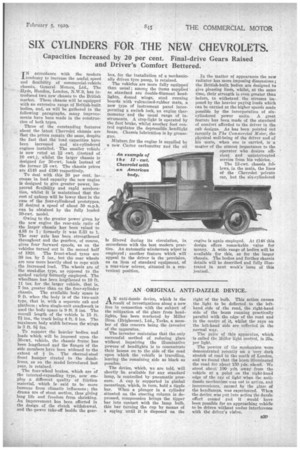SIX CYLINDERS FOR THE NEW CHEVROLETS.
Page 23

If you've noticed an error in this article please click here to report it so we can fix it.
Capacities Increased by 20 per cent. Pinal-drive Gears Raised and Driver's Comfort Bettered.
IN accordance with the modern tendency to increase the useful speed and flexibility of commercial-vehicle chassis, General Motors, Ltd., The Hyde, Hendon, London, N.W.9, has introduced two new chassis to the British market. These chassis will be equipped with an extensive range of British-built bodies, and, as will be gathered in the following paragraphs, many improvements have been made in the construction of both types.
Three of the outstanding features about the latest Chevrolet chassis are that the prices remain the same, despite the fact that the load capacities have been increased and six-cylindered engines installed. The smaller vehicle is now rated at 12 ,cwt. (instead of
10 cwt.), whilst the larger chassis is designed for 30-cwt. loads instead of the former 25 cwt. The chassis prices are 1148 and 1190 respectively.
To deal with this 20 per cent. increase in load capacity the new engine is designed to give greater power, improved flexibility and rapid acceleration, whilst it is maintained that the cost of upkeep will be lower than in the case of the four-cylindered prototypes. If desired a speed of about 50 m.p.h. can be obtained by the fully loaded 30-cwt. model.
Owing to the greater power given by the new engine the rear-axle ratio of the larger chassis has been raised to 4.88 to 1; formerly it was 5.33 to 1. The rear axle has been strengthened throughout and the gearbox, of course, gives four forward speeds, as on the vehicles turned out in the second half of 1928. The front-wheel tyres are 30 ins. by 5 ins., but the rear wheels are now more heavily shod to cope with the increased load. The wheels are of the steel-disc type, as opposed to the spoked variety formerly employed. The wheelbase has been lengthened to 10 ft.
11 ins, for the larger vehicle, that is, 7 ins, greater than on the four-cylinder chassis. The available body space is 9 ft. when the body is of the two-unit type, that is, with a separate cab and platform ; when single-unit coachwork is used the body space is 9 ft. 8 ins, The overall length of the vehicle is 15 ft. 71 ins., the track being 4 ft. 8 ins. The maximum body width between the wings is 3 ft. t.); ins.
To support the heavier bodies and loads which will be imposed upon. the 30-cwt. vehicle, the chassis frame has been lengthened and the flanges of the side members have been widened to the extent of it in. The channel-steel front bumper riveted to the dumbirons, as on the model introduced last year, is retained.
The four-wheel brakes, which are ryf the internal-expanding type, now employ a different quality of friction material, which is said to be more immune from climatic influences ; the drums are of stout section, thus giving Tong life and freedom from shrieking. An improvement has been effected in the design of the clutch withdrawal, and the-power take-off beside the gear
box, for the installation of a mechanically driven tyre pump, is retained.
The vehicles are more fully equipped than usual ; among the items supplied as standard are double-filament headlights, domed wings, steel running boards with vulcanized-rubber mats, a new type of instrument panel ineorporating a switch lock, an engine thermometer and the usual range of instruments. A stop-light is operated by the foot brake, whilst another foot control regulates the depressible headlight beam. Chassis lubrication is by greasegun.
Mixture for the engine is supplied by a new Carter carburetter and the oil is filtered during its circulation, in accordance with the best modern practice. An automatic windscreen wiper is employed ; another feature which will appeal to the driver is the provision, as an item of standard equipment, of a rear-view mirror, situated in a convenient position. In the matter of appearance the new radiator has more imposing dimeusions; the British-built bodies are designed to give pleasing lines, whilst, at the same time, their strength is even greater than before, to withstand the stresses imposed by the heavier paying loads which can be carried at the higher speeds made possible by the incorporation of sixeylindered power units. A great feature has been made of the standard of comfort afforded to the driver in the cab designs. As has been pointed out recently in The Commercial Motor, the physical well-being of the driver and of his mate, when one is carried, is a matter of the utmost importance to the operator who desires Aident and uninterrupted service from his vehicles, The 12-cwt. chassis follows, in the main, the lines of the Chevrolet private car, but the six-eylindered engine is again employed. At 1148 this design offers remarkable value for money. A wide range of bodies will be available for this, as for the larger chassis. The bodies and further chassis details will be described and fully illustrated in next week's issue of this journal.


































